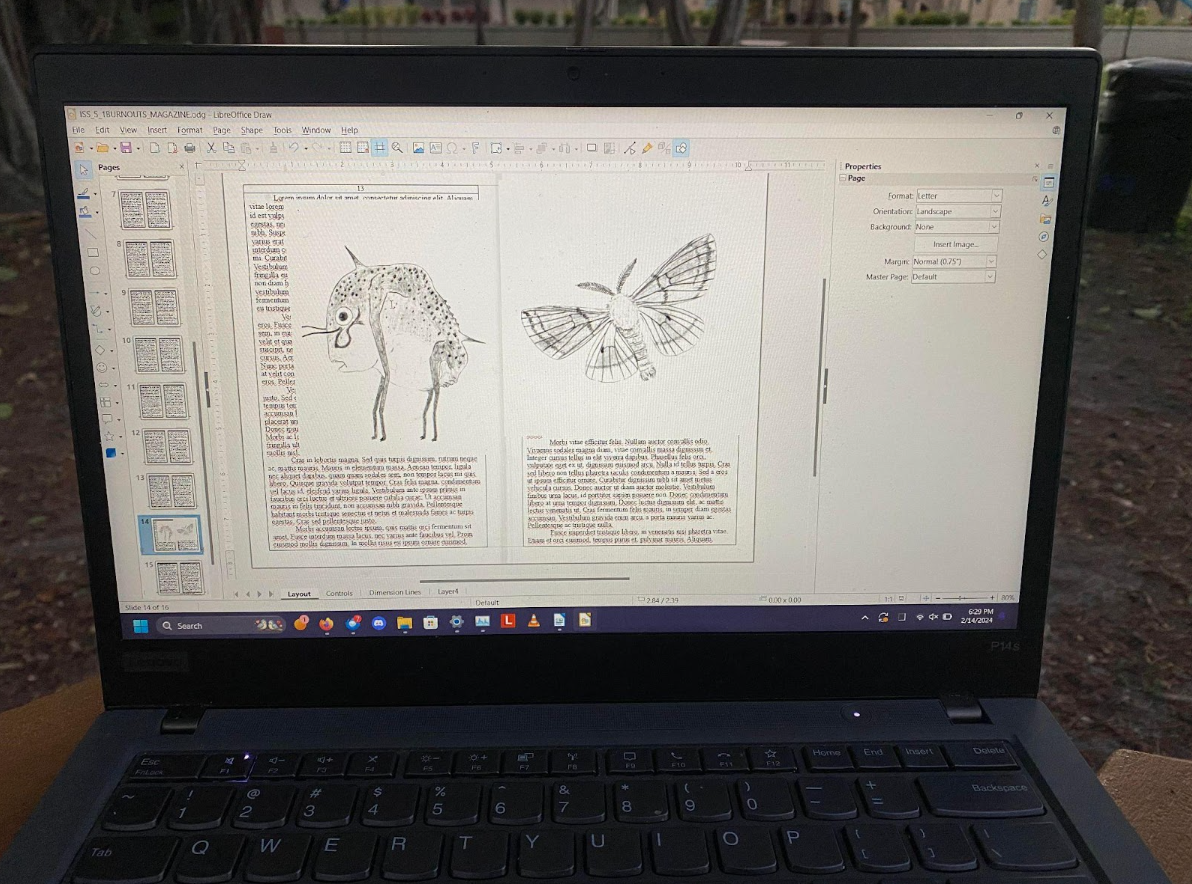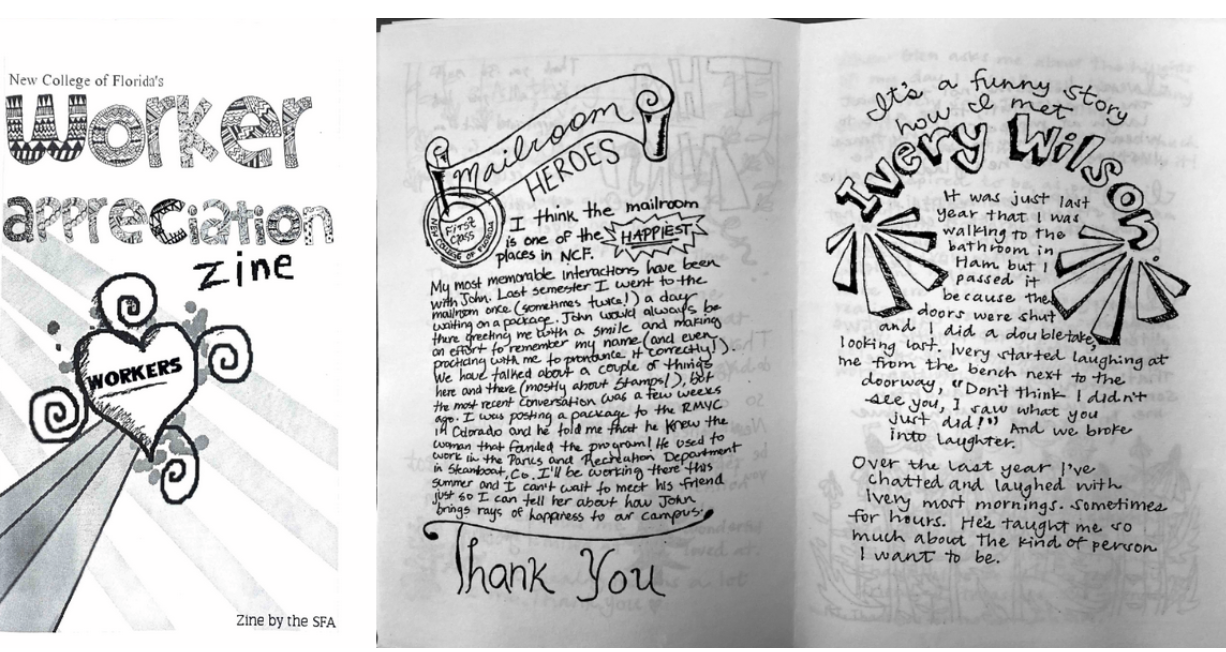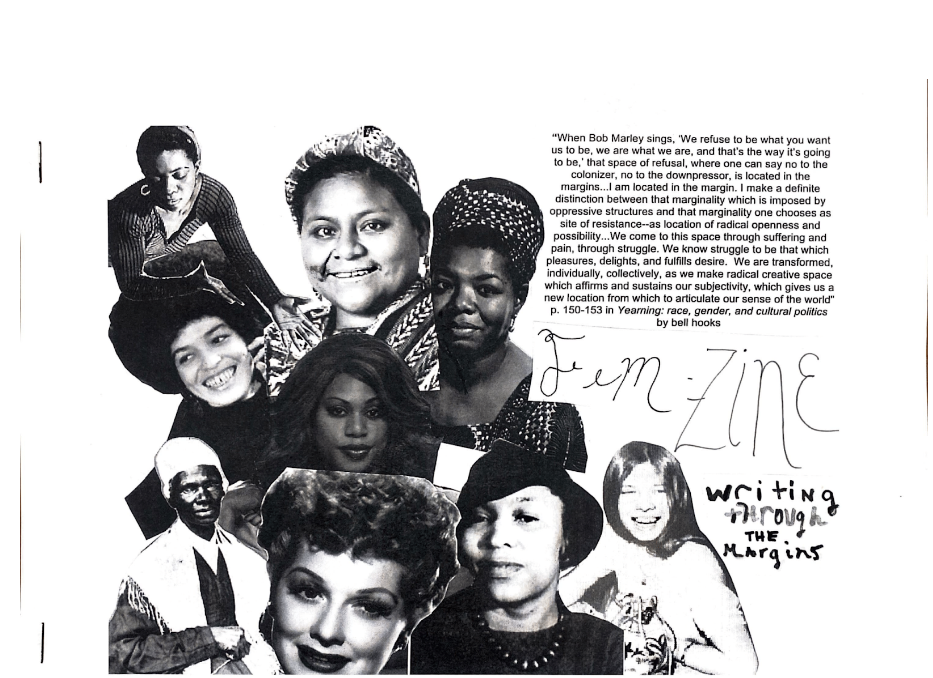A group of students began handing out self-made booklets at Walls last semester. Each copy featured a complex, graphically-designed cover, artwork, poetry and various short, transgressive stories. The issues listed no cited authors, only pen names, but one word in large print stood proudly on every cover: Burnouts. Through the publication’s distribution, a form of communication on campus is being revived from New College’s past – zine culture. Although Burnouts Magazine is recognized by many, the creators and their intentions have been largely a mystery. The Catalyst spoke with two of the authors, who requested to be identified by their noms de plume Florian Piexoto and Raytheon, to understand the behind-the-scenes work that goes into Burnouts Magazine and the ideas fueling its production.
Though distributed in the form of a magazine, Burnouts originated in January 2022 from an unpublished novel by the same name. Florian Piexoto and Raytheon said the zine was inspired by current culture, their long-held aspiration to create a zine and the desire to get more eyes on their work. The issues of the zine often feature segments of their original novel. Other issues are failed writing experiences that the authors revisit and rewrite. Sometimes they simply have an idea and develop it for the issue.
While the authors deny any official ties between the zine and New College, the area of distribution has led to Burnouts’ recognition as a NCF zine. At the very least, Burnouts Magazine can be described as a collaborative Northern Sarasota zine that accepts online writing submissions from anyone interested in the project, sometimes even featuring international submissions. Submission forms are advertised on the zine’s community Discord server, which readers are linked to via QR codes on the issues’ back covers.
A main motivation behind Burnouts’ submission process is to create a space where unconventional voices can be heard. Florian Piexoto, hopes that the zine can become a place where people can connect by promoting their music, literature and art.
“We’re really sympathetic to the idea that people who are shunned or cast out or … aren’t taken seriously by the rest of the community need some place to express themselves,” they commented. “The culture right now is anemic. We’re losing a lot of individual character that makes us so great… We’re all messy and screwed-up people on the inside. A lot of us deny it, and that just results in further problems.”
Raytheon elaborated on the submissions and content they choose to feature in the zine: “I feel like there’s a complete obscurity towards the shadows of society,” they explained. “We don’t really feature people that have their heads screwed on straight… personally because I think most people don’t.”
The production team, staff and writers for the articles come and go, according to Florian Piexoto and Raytheon. Many people write for one issue and then quit or send in submissions inconsistently. Issues of Burnouts typically begin with a theme, cover, or main story that the rest of the issue is based around, and covers are usually produced a few issues in advance.
“With issue six… we’re going back to asking people some questions about what the worst thing they did because of unrequited love was. Already, we have many very interesting results that we’re pretty excited to share,” Raytheon stated.
The name of the zine holds a nuanced meaning, largely inspired by the mid-20th century Beat Generation. “I’m interested in using the term in a beat poet sort of way. The beats use their name in a wide variety of ways – in the sense that they were beat down, downtrodden by society, but also a beat, like a rhythm to it,” Raytheon explained. “There’s a sort of violence or creation implicit in the name. I think the name ‘Burnouts’ is evocative in a similar sense. It’s also a major buzzword, so I think one current desire for the name is to help give a name and backbone to a lot of the artistic movements coming out of this current social environment.”
Raytheon elaborated on how the style of beat author William Burroughs was especially an inspiration for their jump into literary fiction. “Burroughs showed me … how literature could be obscene and lurid and dark and funny, and go into psychedelic yet cartoonish border worlds made not of matter but of evil grit and slime,” they said.
Raytheon’s self-description includes influence by writers such as David Foster Wallace, Thomas Pynchon, Allen Ginsberg and Don Dellilo. Florian Piexoto said they are more influenced by Latin American authors such as Robert Bolano and Mario Vargas Llosa.
The Burnouts authors shared that they are often heavily motivated by current events and try to stay topical with their writings. Florian Piexoto expressed their interest in creating a way for people displeased with the current system to come together.
“America – especially Florida – is basically ‘a Disneyland with a death penalty.’ The simulacra of real life harboring unimaginable scales of illusion and cruelty,” Raytheon stated. “We sort of reject these notions.”
“The political and personal are often pretty hard to separate,” Florian Piexoto commented when asked if they consider their zine to be political. “I would say we’re a zine that’s generally interested in making people … examine the society we live in, but more importantly, be real with themselves, with others; be real about how things are and not act as if everything is perfect, or that they need to just show an outer face of complete composure.”
Another motivation for the authors of Burnouts is to address the failure of the internet, which Raytheon describes as a poisoned well. “It feels as though these places which people our age spent our youths on are dying or becoming something that they didn’t use to be,” they told the Catalyst. “The internet has turned into a dreamspace. In the past it was more like an index or library, but there’s a substantial difficulty in locating a single work of media… I mean, finding an individual TikTok is practically impossible.
“I basically only use Tumblr as a social media website, and even that website is just arguing,” they continued. “It used to be subversive to be on the internet because it was like an escape from mainstream culture. Now that it’s mainstream culture, I feel like it’s what people need to escape from.”
Burnouts production process
Production of the zine comes with its own list of problems, notably the lack of financial support when trying to create a widely distributed work. “The magazine currently has some major setbacks, mostly related to lack of funding,” Raytheon explained. “Other comparable liberal art schools … have stores where students can use their allotted bookstore money on student-run magazines [or] have cultures of leaving zines all over the place for people to read. They have dedicated zine printing places.”
The technical parts of digital creation and formatting can also be a struggle. The initial print runs of Burnouts Magazine were no stranger to unreliable printing, sometimes due to inefficient formatting. “You’d think that getting everything in the right order and getting it to print cleanly isn’t a lot of work, and it’s not if you have a template set up, but you can’t just copy and paste the whole story,” Raytheon explained. “I recommend LibreOffice Draw. It’s basically PowerPoint.
“When people are running small businesses or small presses these days it’s usually on a microblogging site, which unilaterally has stripped all their type-setting features. You can customize maybe a background or something else,” they continued. “But before that, there was this really beautiful style of vernacular graphic design that has been sort of lost, and we’re trying to bring it back.”

Burnouts authors also commented on how much the magazine relies on the contributions and interest of other people. “A lot of the work … is networking,” Raytheon told the Catalyst. “It takes a village to run something like Burnouts Magazine, and it’s very good that a lot of people are willing to drop everything and help us out.”
Though the production of a zine with a wider audience is sometimes stressful, it’s certainly a rewarding process. “I feel like [zines had] fallen out of favor with the student body. A lot of people here probably don’t know what zines are, and it’s a shame because I feel like it’s probably the most instructive pedagogical tool for writers and for artists,” Raytheon shared. “I think zines are one of the most rewarding things an artist can do.”
The Burnouts Magazine creators hope to develop their own publishing business with fewer restrictions for people looking to get their work published, unlike current academic and commercial presses.
“The state of publishing is very dire and it’s wedged between the academic press and the commercial press,” Raytheon said. “Both just censor pretty much anything that is outside of a very narrow set of market confines. We’re hoping to break through and help to nurture some sort of very authentic movement – be a part of a movement that I think historically needs to happen.”
Raytheon commented further on the importance of active involvement in the publishing industry. “If you really care about something like fiction or writing, you should try to get involved on the support end of things, where you’re not just writing or just creating works, especially not consuming works, but being a participant in the economy of things.”
Zines at New College
Kelly Lindberg, a former librarian at Jane Bancroft Cook Library, spoke with the Catalyst about using her love of zines to create a resource for the New College campus. She created the New College Zine Guide, which provides practical information and links about creating zines as well as student theses on zines and zine culture. The NCF libguide includes a section on NCF zine history specifically, covering the history of NCF zine distributions such as Bike Shop Zines and Femzines, as well as linking to the social media pages of a 2018 NCF zine collective effort started by students. Two zine fests have been organized at New College. These fests served as spaces for local artists and zine-makers in the surrounding area to share their work with the community.
Ringling College of Art and Design (RCAD), where Lindberg now works, hosts the Florida Zine Library libguide, providing links to academic zine libraries in Florida and sharing information about upcoming Florida zine fests.
“I was familiar with zines because back in my day we were on Tumblr, which I don’t know if people your age are still using,” Lindberg laughed. “I got really into the punk scene and DIY music community when I was in college, and I’d see zines circulating at punk shows. Then this librarian had a zine-making workshop and I was like wow, that’s really cool! She’s a librarian and … wants to support students in making zines, which I thought … doesn’t necessarily belong at a college in that sort of way, at least my perception of college.”
Lindberg’s college experience with zines is what landed her an internship with her librarian, which spiraled her interest in becoming a librarian herself. Interest in her local community’s zine culture also served as the inspiration for her honors thesis – a short film about just that.
“She approached me and some other students and asked if we wanted to create a collection of zines in our library,” Lindberg stated. “I wanted to give back to college students when I was a librarian at New College, so that’s what I thought of when I wanted to make the New College Zine Guide.”
“A lot of libraries have specialty collections,” Lindberg commented on the topic of zine archiving. “I know that New College has an archive and there are some zines in that archive.”
Unfortunately, the selection in Jane Bancroft Cook Library’s zine archive is slim. Only two zines exist in the physical archive: a Femzine titled “Writing Through the Margins” and a worker appreciation zine by the SFA.


Lindberg also shared her perspective on seeing zines as primary source material while discussing the authority that zine creators have as authors or artists, “A big component of my pedagogy as an instructional librarian is talking about authority and analyzing who has authority,” Lindberg said. “If I talk about that in the context of zines, with zines you are taking your own authority. Maybe a publisher didn’t want to publish your article… you can make a zine about it.”
Zine archivism is not always as simple as it looks, although Lindberg considers the work important. “If someone made a zine documenting a music event they were at, that is a primary source — or documenting the feminist movement, documenting the sci-fi culture they’re into,” she commented. “You have to do your research on an author, and with zines it might be a little bit tricky because some people might not want to expose that they are even the author. You really need to just critique the info in anything you consume. Again, you would just critique a zine and say, ‘Is this an authority?’ ‘Do I trust this source?’”
Lindberg also commented on the influence of technology and the internet on print media and creation, saying she believes it’s something students have come to miss following the COVID-19 pandemic. “I think it’s really important to get hands-on media creation happening. A lot of 2024 is spent with our hands on a cellphone. I really like that zines flip that upside down,” she said.
“I think there’s a real necessity for something new,” Raytheon concluded, “Maybe a return to paper isn’t exactly the way, but certainly the way forward is not through social media websites.”

